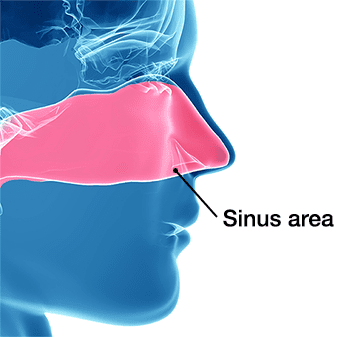What is a sinus lift?
A sinus lift is a surgical procedure that is performed when the molars (back teeth) of the upper jaw are missing, or need to be removed, but there is not enough bone to hold dental implants.
This procedure makes it possible for you to have dental implants placed even if you do not have enough bone in your upper jaw.
The surgery involves raising the floor of the maxillary sinus and filling the space with bone graft material. Over time the bone graft material will harden and integrate with your natural bone, promoting bone growth and improving bone density.
The sinus system has several parts, but it’s the maxillary sinuses that sit closest to your upper jaw and teeth. The new bone material is added between your upper jaw and the maxillary sinuses.
This procedure may also be referred to as a ‘sinus augmentation’, ‘sinus elevation’, ‘sinus graft’, or ‘maxillary sinus floor augmentation’.

Why might I need a sinus lift?
A sinus lift is performed when there is insufficient bone height and bone thickness in the upper jaw, or if the sinuses are too close to the upper jaw, to support a dental implant. This ensures a solid and stable foundation for the dental implants.
Whilst dental implants will fuse with the natural jawbone during a process called osseointegration, successful implant placement requires a certain quantity (and quality) of bone to be present prior to the procedure.
Factors that can cause insufficient bone include:
- Bone recession due to tooth loss:
When the back teeth in the upper jaw have been missing for some time, the natural jawbone deteriorates and resorbs (absorbs back into the body) over time. This also causes an enlarged sinus cavity. - Bone structure may have been lost due to periodontal (gum) disease.
- Because of the anatomy of the skull, the back of the upper jaw naturally has less bone than the lower jaw.
- You naturally have a thin jawbone.
- Your maxillary sinuses are naturally too close to the upper jaw area. The shape and sizes of sinuses do vary from person to person, and they can also grow larger as we age.
Video: Example of bone recession and expansion of the maxillary sinus.
Sinus lift procedure
Prior to the procedure
We will provide a full examination of your dentition (teeth) and take digital radiographs (X-rays) including an OPG (orthopantomogram) and a 3D Cone Beam CT scan. This will allow us to study the anatomy of your jaw and sinus area, as well as accurately measure the height and width of your existing bone.
What’s involved in the procedure
A small “window” is created in the upper jawbone and it is pushed up to reveal the sinus cavity.
The sinus membrane (floor) is gently raised, or ‘lifted’, away from your jaw until the ideal jaw height is created.
The space is then filled with bone graft material.
Once the new bone is in place, the gum tissue is closed with stitches (sutures) and allowed to heal.
Video: Sinus lift procedure.
Sinus lift procedure illustrations:


Please note, any surgical or invasive procedure carries risks. Before proceeding you should obtain personal advice from an appropriately qualified health practitioner.


